Market Trends & Data
Market News & Data
General Info
Real Estate Strategies

Landlording & Rental Properties
Real Estate Professionals
Financial, Tax, & Legal



Real Estate Classifieds
Reviews & Feedback
Updated 8 months ago on . Most recent reply
- Real Estate Broker
- Greater Charlotte NC and Charleston, SC areas
- 58
- Votes |
- 105
- Posts
Nationwide Housing Stats - And September / November Rate Cuts...
What a week! We had a huge downward revision to the BLS jobs growth figures, the Fed minutes explicitly said that a rate cut on Sept 18 was likely, and average mortgage rates moved below 6.5% (and are now 1% lower than they were a year ago).
July housing starts disappoint. New home starts fell 7% month-over-month to 1.24 million units (annualized) — their lowest level since July 2019 (excluding the onset of COVID). [Much more on this later.] [Census Bureau]
818,000 jobs — GONE. Every quarter we get the QCEW (Quarterly Census of Employment and Wages). The latest QCEW showed that the job gains previously reported by the BLS between March 2023 and March 2024 had been revised lower by 818,000!
TP: Jerome Powell and the other Fed members will have to take this into account. Instead of average monthly job gains of 242K, it was actually 174K — a downward revision of 28%.
Fed minutes let the cut out of the bag. The notes from the Fed’s last meeting (held on July 30–31) included a big reveal: “The vast majority [of Fed members] observed that, if the data continued to come in about as expected, it would likely be appropriate to ease policy at the next meeting.”
TP: Keep in mind that the last Fed meeting happened before: 1) the July unemployment rate jumped to 4.3%, 2) July CPI came in lower than expected, and 3) the huge, downward QCEW revisions to jobs growth. It’s looking more and more likely that Mr. Powell might have something exciting to say at Jackson Hole.
Million dollar listings. They aren’t so rare anymore. According to Redfin, 8.5% of homes in the US are worth more than $1 million. That percentage was 4% before the pandemic sent home prices rocketing nationwide. [Redfin]
TP: This is really just an attention-grabbing alternative to saying that prices have risen a lot. Think about it: if we assume that prices rose 40% during the pandemic, that means that any home that was worth between $700K-$999K before COVID is now valued above $1 million. And, of course, the ones that were worth more than $1 million before COVID are still worth more than $1 million. In other words, that percentage will only rise (unless prices begin plunging).
Existing home sales rebound, sort of. July existing home sales rose 1.3% month-over month, (-2.5% year-over-year) to 3.95 million units (seasonally-adjusted and annualized). It looks like transaction activity has finally bottomed, but we're still deep in the trough. The median sales price fell 1.0% month-over-month to $423K, but was still up 4.2% year-over-year. [NAR]
TP: Over the last 2.5 years, existing home sales have declined month-over-month in 25 out of 30 months. But with the sharp decline in mortgage rates since May, the moribund housing market is showing signs of life.
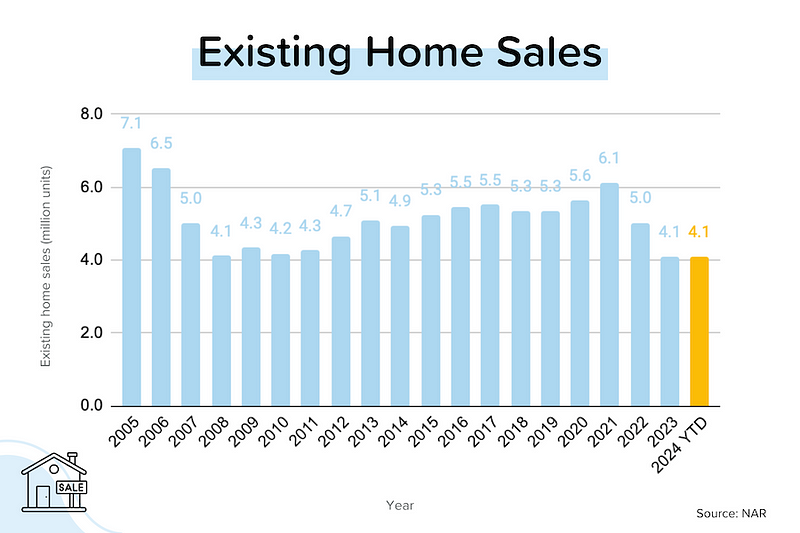
Confidence rising; competition falling. It's very normal for competitive ferocity to begin waning in July/August. The latest Realtors Confidence Index showed a decline in the % of homes sold above list price (29% in June → 24% in July), the number of offers per sale (2.9 → 2.7), and the number of homes sold in less than a month (65% → 62%). But unusually for this time of the year, more Realtors see rising buyer demand in the next 3 months (13% → 16%). [NAR]
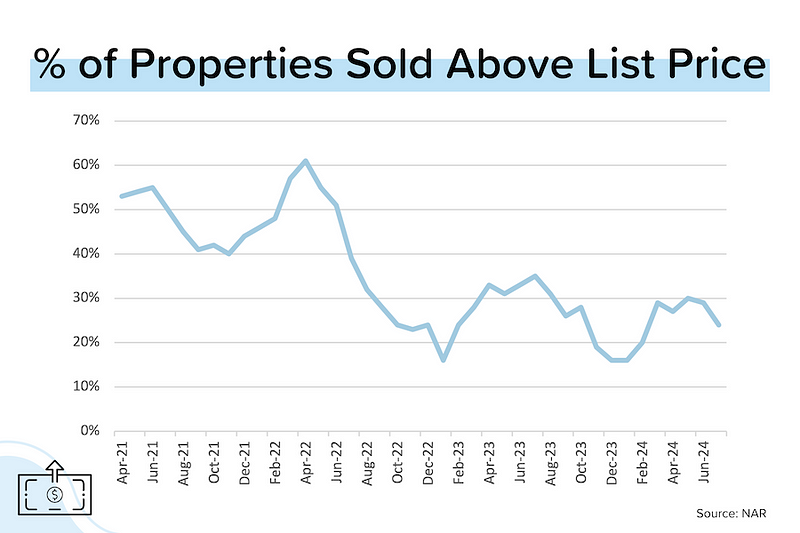
The “hottest” zips. The ZIPs in Realtor.com’s Top 10 are seeing nearly 4x as many views per listing and selling 1 month faster than the typical home nationally. All of them are located in Midwestern or Northeastern metros. #1 was Gahanna, OH (Columbus). #2 was Ballwin, MO (St. Louis). #3 was Salem, MA (Boston/Cambridge). [Realtor.com]
Starts & Permits: Long-term PerspectiveHousing starts disappointed in July 2024, falling 7% month-over-month to 1.24 million units (SAAR). But let’s zoom out and look at housing starts (this is single family + multifamily) over the last 60 years. Three things stand out from the graph below:
- New home construction is wildly cyclical
- New home construction really hasn’t grown in 6 decades, but
- Our population has risen by 150 million over the same time period!
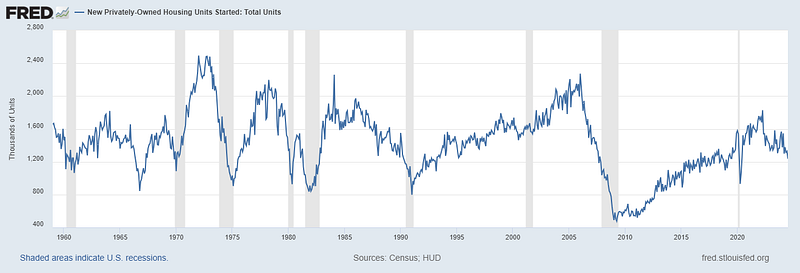
So what’s the problem? It’s a lot of things. As I’ve written previously, the Top 20 builders have been rapidly gaining nationwide market share (>50% in 2023 vs. 33% in 2013). Most of them are listed companies (they have a stock price), which means they really care about margins and earnings growth. The shortage of available housing is GOOD for them. Nobody (including the NAHB) talks about this.
Second, it’s become far more complicated to build new homes from a regulatory standpoint (takes longer, costs more). Third, labor shortages. The NAHB talks about these. Let’s look at the impact those last two have had on the time it takes to deliver a new home (or apartment building).
Stages in New Home Construction
- Application for Construction Permit
- Permit Approval (2–12 months after application depending on where/what you want to build)
- Start (2.8 months after approval for MF, 1.3 months after approval for SFH)
- Under Construction
- Completion (17 months after start for MF, 8.3 months after start for SFH)
What does this mean? From the time that your new apartment complex gets its permit approved to the building being completed could take 20 months. If you include the time waiting for your application to be approved, it could easily be 2 years.
These timelines keep getting stretched out. Just look at the average number of months from Start to Completion for Multifamily buildings over the last 50 years. 17 months is a record! This tells a familiar story of labor and material shortages.
Note: Obviously, a big part of the recent rise is COVID-related. I would hope to see that figure drop in 2023. Even if it does, it will still be very high relative to history.
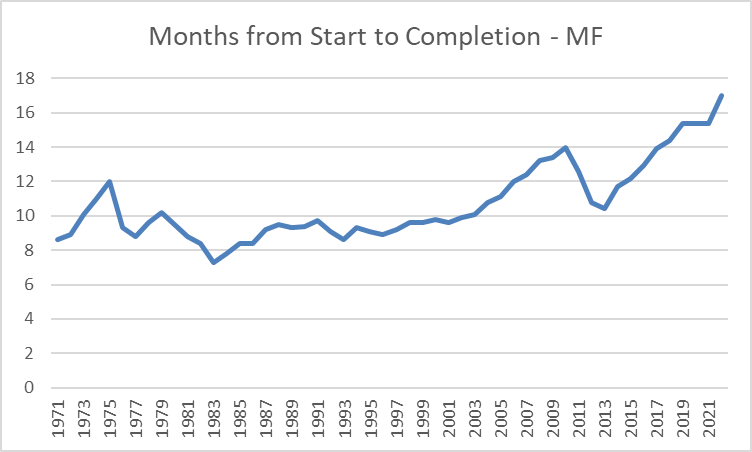
Source: Census Bureau
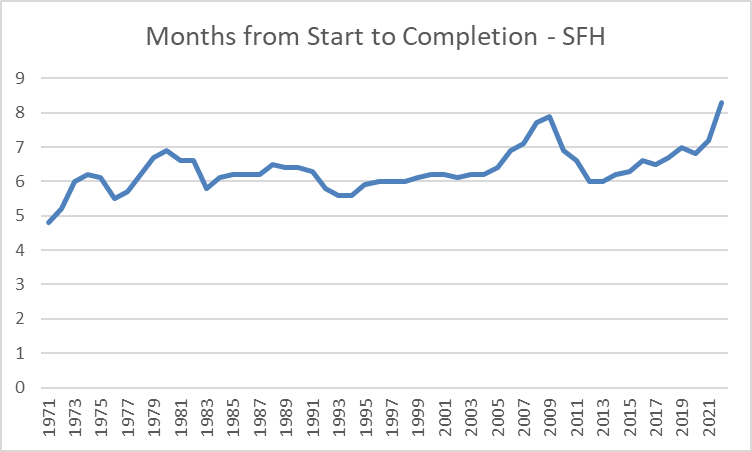
Source: Census Bureau
Realtors Confidence IndexCompetition levels typically peak around June. After June, inventory tends to build (days on market rises), there are fewer bidding wars, and a smaller percentage of homes sell for more than their listing price. You can easily see that seasonality in most of the charts below. With that in mind, it’s worth noting that:
- Competition levels are much lower than they were during the pandemic housing boom
- Competition levels are a bit lower than they were at the same time last year, but
- Realtors are a bit more optimistic about the future than they were at the same time last year, thanks to lower mortgage rates
Outlook for Increasing Buyer Traffic
It’s unusual for this % to be rising in July. But that’s exactly what it did, climbing from 13% in June 2024 to 16% in July 2024. Why? It’s all about lower mortgage rates. It will be VERY interesting to see how these three factors influence existing home sales over the next 3 months:
- Seasonal slowdown (-)
- Mortgage rates dropping (+)
- Buyers potentially paying their own buy-side brokerage commissions (-)
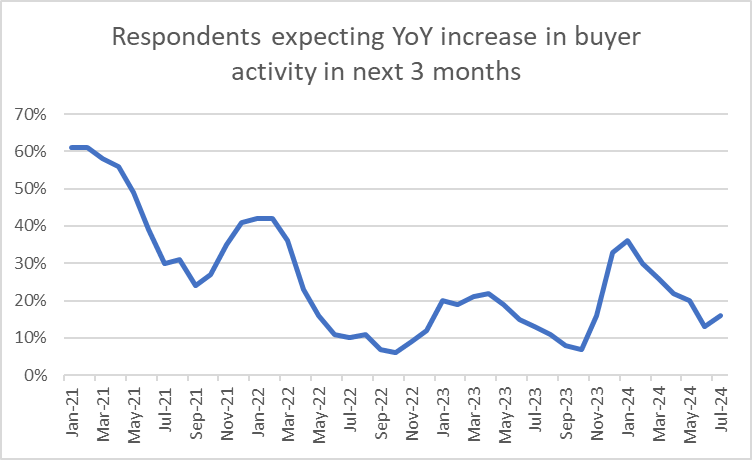
Average Number of Offers Received per Sale
The average home sold in July 2024 had 2.7 offers, down slightly from 2.9 in June 2024, and well below 3.0 in July 2023. Remember that this is a national average: in some areas, there are more than five offers per home sold; in others, just one.
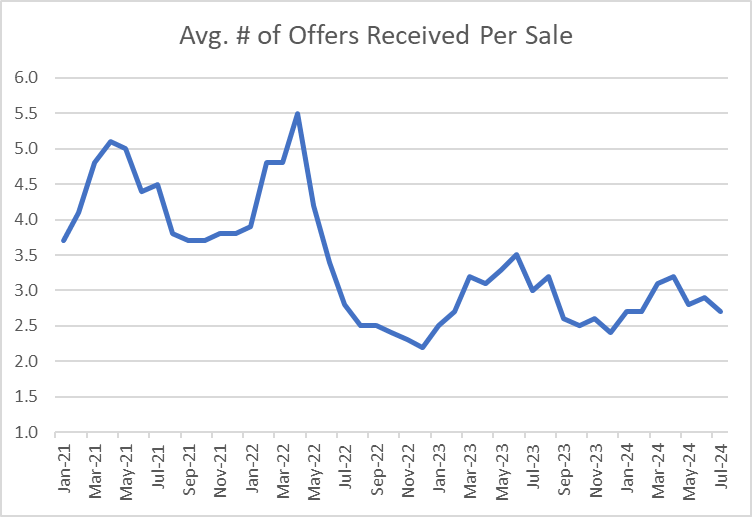
% of Homes Sold Above List Price
24% of the homes sold in July 2024 transacted above their initial listing price. That was down from 29% in June 2024 and 35% in July 2023.
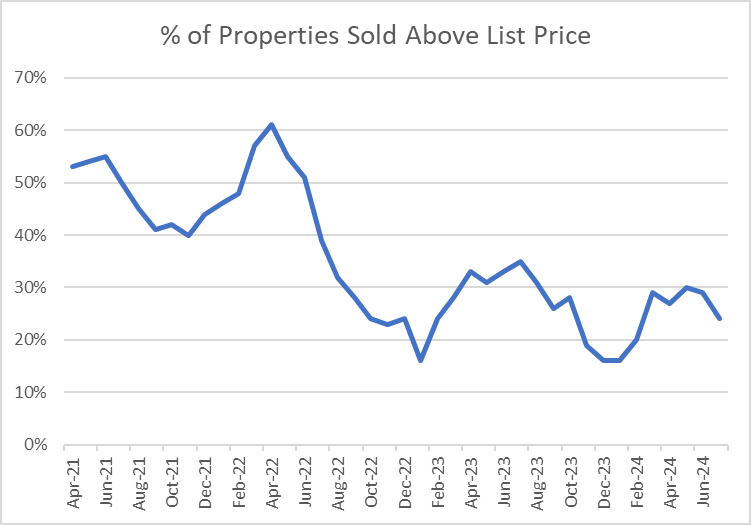
Days on Market
The typical home sold in July 2024 had been on the market for 24 days. That was up from 22 in June 2024, and 20 in July 2023. As the chart suggests, we should begin to see a sharp rise in DOM (homes lingering on the market longer) in the coming months.
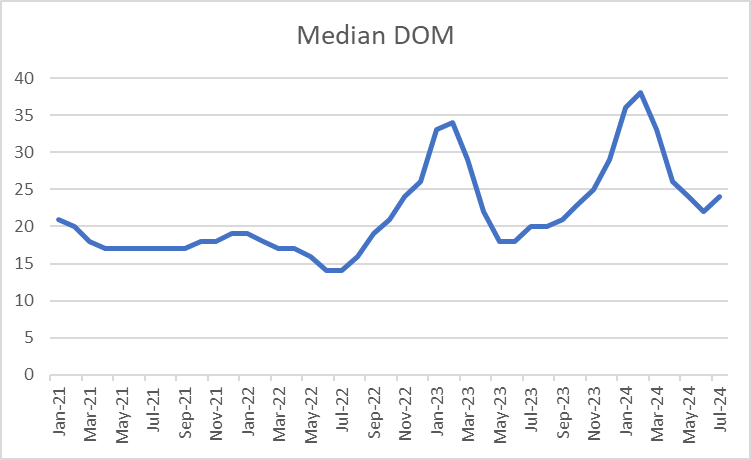 Mortgage Market
Mortgage Market
Average 30-year mortgage dropped below 6.5% this week. That’s more than 1% lower than they were a year ago. In fact, mortgage rates have dropped 70 basis points (0.7%) since the beginning of May! This will eventually boost transaction volumes. The 1% MoM increase in July existing home sales was just a taste.
Here are the current odds on Fed rate cuts at upcoming FOMC meetings:
- Sept 18: 100% (same as last week); the probability of a 50 basis points cut roughly steady at 25%.
- Nov 5: US presidential election
- Nov 7: 100% (same as last week); 39% probability that rates will be 75 basis points lower than current
- Dec 18: 100% (same as last week); 44% probability that rates will be 100 basis points lower than current.
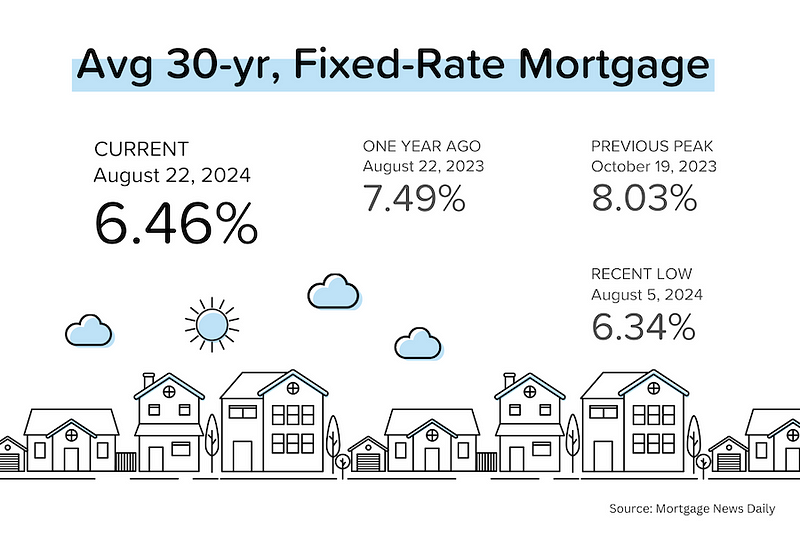 They Said It
They Said It
“Despite the modest gain [in July], existing home sales are still sluggish. But consumers are definitely seeing more choices, and affordability is improving due to lower interest rates.” — Lawrence Yun, NAR's Chief Economist
- Kristen Haynes
